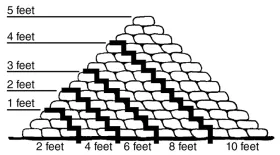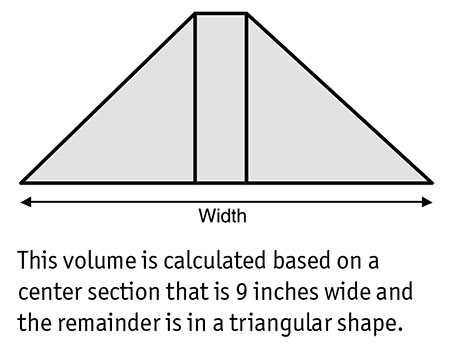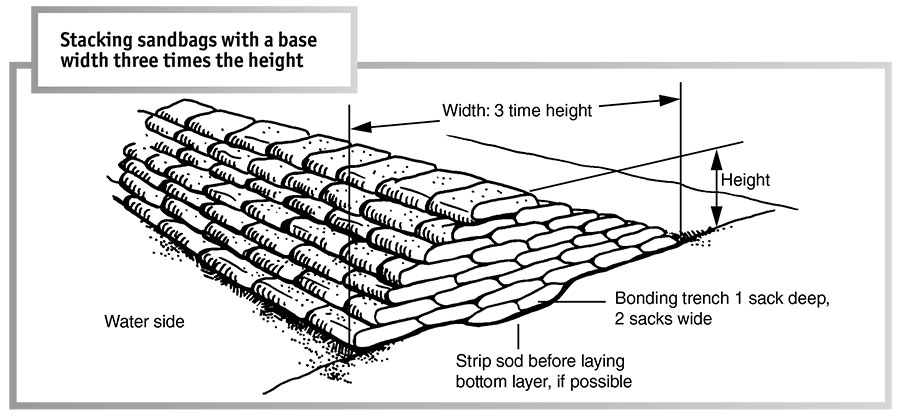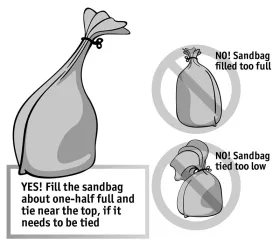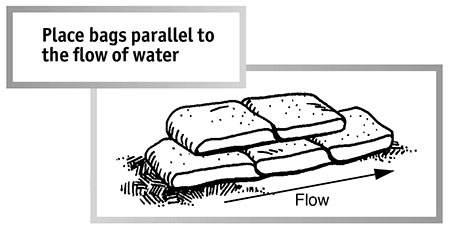Dimensions of a dike that is twice as wide as it is tall
Build the dike at least 1 foot higher than the projected crest level to allow for fluctuations in the water level. Local experience will assist in determining the amount of freeboard to provide.
The U.S. Army Corps of Engineers recommends building a dike with a width at the base that is three times the dike height. For example, a 4-foot-high dike would have a base width of 12 feet. The corps indicates that each foot of finished dike length requires one bag, each foot of height requires three bags, and each 2.5 feet of width requires three bags. This results in each bag having placed dimensions of about 4 inches high by 10 inches wide by 14 inches long.
Estimated cubic yards of sand needed per 100 feet of dike length for various dike heights and ratios of height to width. An additional 2 cubic yards will be needed for bags to hold the plastic.
Dike Height (ft.)
| |
|
1.0 |
1.5 |
2.0 |
2.5 |
3.0 |
3.5 |
4.0 |
4.5 |
5.0 |
| Cubic Yards of Sand |
Width
3xH |
7 |
15 |
25 |
38 |
54 |
73 |
95 |
119 |
145 |
| |
Width
2xH |
6 |
11 |
18 |
27 |
38 |
50 |
65 |
82 |
100 |
Use the following equation to estimate the number of bags required per linear foot of dike for a dike with a base width that is three times the height.
N = (3 x H) + (9 x H x H) / 2
N – Number of bags required per linear foot of dike
H – Dike height (feet)
Example:
Estimate the number of bags required per linear foot for a dike 3 feet tall.
N = (3 x 3) + (9 x 3 x 3) / 2 = 45 bags
The estimated number of bags needed for 100 linear feet of dike is:
1-foot-high dike: 600
2-foot-high dike: 2,100
3-foot-high dike: 4,500
4-foot-high dike: 7,800
A common recommendation is to make the dike twice as wide as its height. This is a minimum width-to-height ratio that should be used. The estimated number of bags needed for this ratio is in the following table. This is based on each bag having placed dimensions of about 4 to 5 inches high by 9 to 10 inches wide by 14 inches long.
The estimated number of bags needed for 100 linear feet of dike that it twice as wide as its height is:
1-foot-high dike: 600
2-foot-high dike: 1,700
3-foot-high dike: 3,000
4-foot-high dike: 5,500
5-foot-high dike: 9,000
A cubic yard will fill about 100 30-pound sandbags or about 75 40-pound bags, assuming the sand weighs 110 pounds per cubic foot. Sand weighs 100 to 130 pounds per cubic foot, depending on moisture content and packing. A cubic yard is 27 cubic feet. Each 14-inch by 24-inch bag will hold about 0.4 cubic feet if filled about one-half full. Based on volume, each yard will fill about 67 bags one-half full.
